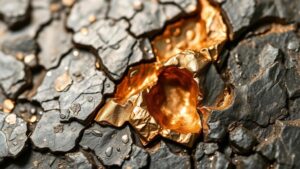Recognizing Indicators of Replacement Deposits Containing Silver
Recognizing Indicators of Replacement Deposits Containing Silver
Replacement deposits are formed when mineral-rich fluids percolate through existing rock formations, causing a substitution of one mineral for another. This article focuses on how to recognize indicators of replacement deposits specifically containing silver, a precious metal with significant economic and industrial value. Understanding these indicators is crucial for geologists, mining professionals, and investors in the mineral resource sector.
The Geochemical Landscape of Silver Deposits
Silver is often associated with various geological environments. Recognizing geochemical indicators can aid in the identification of potential silver replacement deposits. Key elements that frequently accompany silver in replacement deposits include:
- Lead (Pb)
- Zinc (Zn)
- Copper (Cu)
- Gold (Au)
For example, the presence of galena (PbS) often indicates a proximity to silver deposits. In the Coeur dAlene Mining District in Idaho, high concentrations of lead have been correlated with silver mineralization, illustrating the importance of geochemical indicators.
Textures and Structures
Textures in the host rock are another vital indicator of silver replacement deposits. Look for:
- Brecciation
- Replacement textures, such as pseudomorphs
- Mineral zoning
Brecciation occurs when rocks break apart–often due to mineral replacement–creating voids filled with silver-bearing minerals. A notable case is found in the Palomares mine in Spain, where intricate brecciated textures correlate with significant silver discoveries.
Alteration Patterns
Alteration of surrounding rocks can signal the presence of silver deposits. Key alteration types include:
- Silicification
- Argillization
- Carbonatization
Silicification, where the original rock is replaced by silica, often indicates high-temperature hydrothermal activity conducive to silver deposition. For example, the famous Comstock Lode in Nevada featured pervasive silicification associated with high silver grades.
Geophysical Indicators
Geophysical methods, including magnetic and resistivity surveys, are useful for detecting silver deposits. Silver-rich deposits typically exhibit distinctive geophysical signatures. Commonly used techniques include:
- Induced Polarization (IP)
- Ground Magnetic Surveys
IP is particularly effective because silver and its associated minerals often display chargeability responses. For example, the use of IP in exploration campaigns in Mexico has yielded promising targets for silver mining.
Field Sampling and Assay Techniques
Field sampling is essential for confirming the presence of silver in suspected replacement deposits. Techniques include:
- Rock chip sampling
- Soil geochemical surveys
- Drill core sampling
Rock chip sampling, when done correctly, can provide a snapshot of the mineralization potential in an area. For example, in the Zacatecas district of Mexico, systematic rock sampling led to new discoveries of silver-rich veins that had previously been overlooked.
Case Studies: Successful Exploration of Silver Replacement Deposits
Several mining operations exemplify the successful recognition of indicators leading to productive silver replacement deposits. One notable case is the San José mine in Argentina, where extensive studies of both geochemical and geological data led to the identification of substantial silver veins within a replacement deposit framework.
Similarly, the Sinking Creek project in British Columbia utilized a combination of geological mapping, geophysical surveys, and detailed sampling to delineate significant silver-rich zones within previously mined areas.
Conclusion: Actionable Takeaways
Recognizing indicators of replacement deposits containing silver involves an interdisciplinary approach, integrating geology, geochemistry, and geophysics. By focusing on the geochemical landscape, rock textures, alteration patterns, geophysical anomalies, and thorough sampling techniques, professionals can effectively identify potential silver-rich sites for further exploration.
As the demand for silver in industries such as electronics, photography, and renewable energy continues to grow, recognizing these indicators will be essential for sustainable mining practices and strategic resource management.

